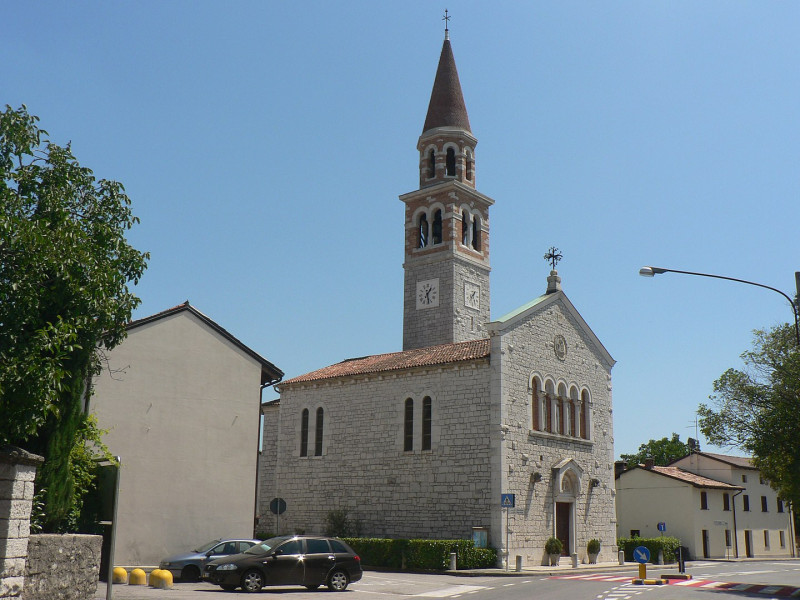Doberdò del Lago
Doberdò del Lago (Slovene: Doberdob) is a comune (municipality) in the Province of Gorizia in the Italian region Friuli-Venezia Giulia, located about 30 kilometres (19 mi) northwest of Trieste and about 11 kilometres (7 mi) southwest of Gorizia, and borders the following municipalities: Duino-Aurisina, Fogliano Redipuglia, Komen (Slovenia), Miren-Kostanjevica (Slovenia), Monfalcone, Ronchi dei Legionari, Sagrado, and Savogna d'Isonzo. It is located in the westernmost part of the Kras Plateau. It is inhabited mostly by Slovenes. Before World War One, Slovene-speakers comprised almost the totality (around 99%) of the population. In the 1971 census, 96% of the inhabitants were Slovene-speaking. Since then, the number of Slovenes has slightly fallen, mostly due to the increased immigration of Italian speakers from neighboring towns of Monfalcone and Ronchi dei Legionari. Today, an estimated 86% of the inhabitants belong to the Slovene ethnic minority. Doberdò localities include Devetachi, Jamiano, Marcottini, and Visintini. Geographical location Doberdò is the only municipality in the Province of Gorizia that lies entirely on the Kras (Carso) plateau. The Doberdò area has a crucial strategic position. Throughout the middle of the municipality, in fact, runs a relatively wide and flat canyon that stretches from north to south, connecting the Vipava Valley to the Adriatic sea. The canyon is called simply Dol (Slovene for vale). The main road between Gorizia and Trieste runs through this canyon, which is the most direct connection between the Goriška region and the seaside. At its southern edge, the Dol Canyon widens into a typical karst polje, dominated by Lake Doberdò. The village of Doberdò is located west of Dol Canyon, on an elevated section of the Carso Plateau known as the Doberdò Karst (Carso di Doberdò, Doberdobski Kras). On the east side of the Dol Canyon rises the plateau known as the Trieste and Komen Karst (Tržaško-komenski Kras), which continues eastward and southward into neighboring Slovenia. Dol Canyon ends in the narrow Timavo Valley, which is already located in the neighboring municipality of Duino. History see also: Gorizia and Gradisca, Italian Front (World War I), Julian March, Operational Zone Adriatic Coast The Slavic ancestors of the present-day Slovenes settled the Kras plateau in the 7th century AD. In the Middle Ages, the village belonged to the Lombard kingdom, the Frankish Kingdom, to the Patriarchate of Aquileia, and finally to the Counts of Gorizia which acquired it in the 15th century. The village was first mentioned in 1179 as Dobradan. This was probably as misspelling of the Slovene name Doberdob. Together with the rest of the County of Gorizia, Doberdob came under Habsburg rule in 1500, and remained part of the Habsburg Monarchy until 1918, when it was occupied and annexed to Italy. The whole area was the scene of fierce fighting between the Austro-Hungarian and the Italian Armies during World War I. The village was completely destroyed during the Battles of the Isonzo. More than a fifth of the population lost their lives as a consequence of the war. Between 1922 and 1943, Doberdob was subjected to a policy of violent Fascist Italianization. During this period, the village was part of the Province of Trieste. During World War II, the Communist-lead Liberation Front of the Slovenian People organized anti-Fascist resistance in the area starting from late 1942. Many locals fought and died in the Yugoslav partisan units. The village was liberated by the Yugoslav People's Army on 1 May 1945. The Yugoslavs withdrew already in June of the same year, and were replaced by the Anglo-American Military administration. In September 1947, the village was reincorporated into Italy, and was included in the Province of Gorizia. Between the mid 1950s and the late 1980s, Doberdob was one of the electoral strongholds of the Italian Communist Party, although a significant proportion of the electorate also supported the Slovene Union, the democratic party of the Slovenes in Italy. Since the 1990s, the vast majority of the population has supported one of the left-wing political parties. Culture and education The village has a state-run preschool, elementary school, and high school, all of them with Slovene as the language of instruction. The elementary school is named after the Slovenian writer Prežihov Voranc, while the high school is named after Ivan Trinko, a Slovene bishop, author and minority rights activist from Friulian Slovenia. Most locals speak in the Karst dialect of Slovene. There are many cultural and civic associations in the municipality. Symbolic place of WWI During World War I, the village was the scene of the Battle of Doberdò. Since many Slovene soldiers fought in the battle as soldiers of the Austro-Hungarian Army. A popular war song Doberdob with the verse "Doberdob, slovenskih fantov grob" ("Doberdò, the grave of Slovene lads"), made the name of the village known all across the Slovene Lands. In 1940, the Slovene writer Prežihov Voranc chose the name of the village as the title for one of his best-known novels, Doberdob (undertitled: "The War Novel of the Slovene People"). With this novel, Doberdò became the central symbolic place of the Slovene victims in World War I. Doberdò is also a symbolic place for the Hungarians, since many of them died in the battle fighting in the Austro-Hungarian Army. In Hungary, there is a popular war song with the name Doberdó, reminiscent of the battle. In May 2009, a chapel commemorating the Hungarian victims of the Battles of the Isonzo was inaugurated in the hamlet of Visintini (Slovene: Vižintini) with a trilingual, Italian-Hungarian-Slovene inscription. Notable natives Notable people born in the municipality of Doberdò include the Slovenian liberal economist Milko Brezigar, the Slovenian social-democratic politician and lawyer Josip Ferfolja, and the Italian cyclist Giorgio Ursi (Jurij Uršič). Twin towns Bled, Slovenia, since 1998 Prvačina, Slovenia, since 1977 Újfehértó, Hungary See also Julian March Gorizia and Gradisca References External links Official website

